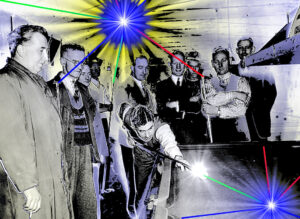Is kinetic energy conserved in impulse? When asked this question, the studies show a green signal saying yes, kinetic energy is conserved in an impulse.
Kinetic energy and impulse are both correlated in terms of the motion of an object that comes under the influence of gravitational force. Impulse is the kind of force that kicks starts the momentum in the system under motion.
Generally, impulse force is how the momentum changes and is determined by the very same. We also must know the understanding between impulse and kinetic energy. Both are two different quantities.
For instance, during the elastic collision, the kinetic energy is conserved, and this condition is called only when the collision is elastic. In this way, impulse also contributes to the very same. So kinetic energy is conserved in an impulse.
For example, if we consider the collision of two particles in an isolated system, they will collide with each other in their kinetic energies. So when the impulse force is applied to the system, the momentum instantly changes.
When the momentum changes according to the system’s speed at which it collides, then the energies will also be altered. Hence if the collision seems to be elastic, there will be a conservation of kinetic energy despite the momentum conservation or not.
We also know that friction contributes to the system’s motion that is under motion. So when there is strong friction happening, the momentum and impulse will face a sudden change, and it cannot be said if the momentum will be conserved.

Why is kinetic energy conserved in impulse?
First, let’s see the fundamental factors that most prominently influence the isolated system that is in motion or collision. It is the momentum, impulse, force, kinetic energy, and force of gravity.
We must take the quantities that directly affect the collision and the conservation of the kinetic energy and the system’s momentum under collision. We often consider the collision part alone is because it gives a clear understanding of all kinds of conservations.
The answer to why kinetic energy is conserved in impulse is that the impulse force exerted by one body over the other is generally conserved if the momentum is conserved. And in turn, the kinetic energy is conserved as well.
Whenever there is impulse given to the system under motion or any motion, sometimes collision will result in the change in momentum. So this momentum is nothing but is used to enhance the object’s mass that is required to move furthermore when velocity changes.
For example, there is the car moves at a particular speed on the road, there is enough velocity for that mass of the body. Now since there is no other vehicle on the road, the driver wants to increase the car’s speed that is moving on the road.
So now, to change the speed and go further, internally, the impulse force is applied, and the momentum changes. This change in momentum gives the car the power to move further with the change of speed.
Also, by this way, the kinetic energy will be conserved if only the impulse is conserved and the momentum is conserved.

How is kinetic energy conserved in impulse?
A better understanding must be given so that we are clear about what is happening when the momentum or impulse is conserved.
The momentum is conserved in a system when no external force is applied to the system. In this way, the impulse is conserved automatically. And this is how kinetic energy is conserved in impulse.
The before and after collision process has the momentum conserved when it runs with the help of an internal force and when the external force is not applied also it should be equal to zero.
There must be a conservation of kinetic energy and momentum in an elastic collision. Before the collision, the kinetic energy is zero at rest. The momentum will also be zero. But once the system comes under motion and the kinetic energy is activated, the system will instantly gain momentum.
So when this happens, the kinetic energy of the system will face a change after the collision. When the kinetic energy of the colliding system before and after the system is the same, the system is said to be conserved.
Is energy conserved in impulse?
In an elastic collision, quantities such as momentum and impulse kinetic energy should be conserved as they have the same value before and after the collision.
Energy is indeed conserved in an impulse. We shall consider an example to illustrate this better for a better understanding. We can consider dropping the ball from a particular height. So before dropping the ball, the kinetic energy of the ball is zero.
At the momentum of dropping the ball, it will possess kinetic energy and move downward due to gravity. There will be an instant creation of change in momentum, which is also due to impulse force.
This impulse force is the exertion of the force from the hand to the ball. In simple words, it can be said that the force is transferred from the hand to the ball that is being dropped, and the energy is conserved. This is also by Newton’s Third Law.
Several other examples also come under the same concept of conservation of energy in an impulse. After the motion, the motion the kinetic energy will be the same before the collision. This condition proves that is kinetic energy conserved in impulse.

Frequently Asked Questions
What is energy conserved?
The basic notion of conserving energy is to save energy from excess consumption, which can be applied to any other purpose to carry on the process.
During a collision, in a few cases, it is made sure that the energy is conserved because that energy is not lost after the process. The conserved energy is used internally. We know that momentum is not conserved when the external force is applied. To make sure of this, experimentally, the energy can be saved.
In an inelastic collision, how is momentum conserved but not energy?
We must know that momentum is a vector quantity and energy is a scalar quantity. So in an inelastic collision, energy will be conserved.
In an inelastic collision, the momentum will not be conserved. Since energy is a scalar quantity, it has only magnitude. From all the science we’ve learnt it is evident that moment is a vector quantity and energy is a scalar quantity. When the magnitude remains the same direction may vary. Hence in a collision when energy isn’t conserved the momentum has the possibilities to be conserved.
What is the relationship between impulse and kinetic energy?
There is one central relationship between impulse and kinetic energy and velocity.
Both impulse and kinetic energy are related to the same velocity of the system on which it is working. We know that momentum is connected to the impulse because the impulse comes to act when the momentum changes. So velocity is the one that binds impulse and kinetic energy together. The system under motion having a particular velocity will connect both the impulse and the kinetic energy.
Also Read:
- Example of chemical to mechanical energy
- Does mass affect potential energy
- Example of mechanical to sound energy
- Solar energy to heat energy
- Can potential energy be negative
- What is the kinetic energy of light
- Electrical energy to heat energy
- Potential energy to kinetic energy example
- What increases potential energy
- Conservation of mechanical energy examples
Hi…I am Keerthana Srikumar, currently pursuing Ph.D. in Physics and my area of specialization is nano-science. I completed my Bachelor’s and Master’s from Stella Maris College and Loyola College respectively. I have a keen interest in exploring my research skills and also have the ability to explain Physics topics in a simpler manner. Apart from academics I love to spend my time in music and reading books.
Let’s connect through LinkedIn